Moss Acres Racetrack Site
University of Florida Vertebrate Fossil Locality MR012
Location
About 3.5 miles (5.6 km) east of Morriston, Marion County, Florida; 29.28° N, 82.38° W.
Age
- Late Miocene Epoch; late early Hemphillian (Hemphillian 2 interval) land mammal age
- About 6 to 7 million years old (estimated)
Basis of Age
Vertebrate biochronology. A late early Hemphillian (Hh2) age is indicated by co-occurrence of the sloth Pliometanastes protistus, the rhino Aphelops mutilius, and the equids Cormohipparion plicatile, Cormohipparion emsliei, and Neohipparion eurystyle. A Hh3 age is not completely ruled out but would require more substantial range extensions than Hh2.
Geology
Massive, dense, clay deposited within a depression of the limestone bedrock. When freshly exposed, the clay was green in color, but weathered to a dull brown.
Depositional Environment
Ancient pond or lake that formed within a sinkhole. The fine-grained clay sediments indicate an environment with very still water.
Fossils
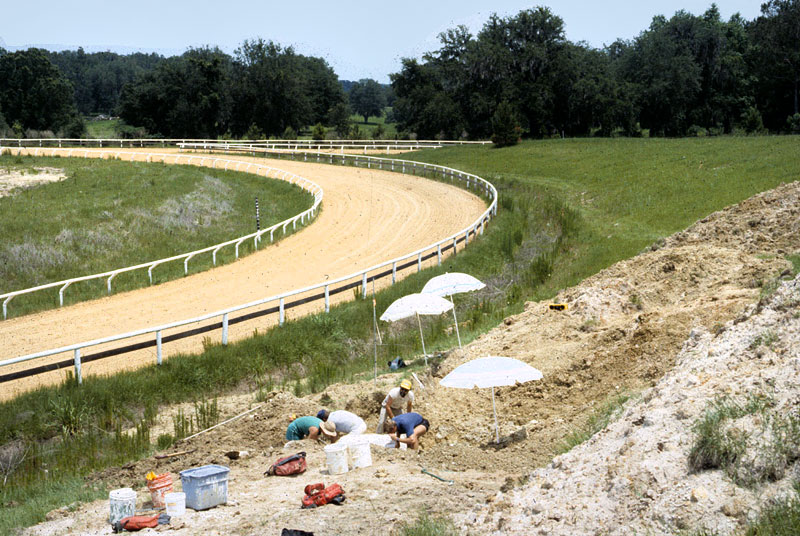
Excavation History and Methods
The Moss Acres Racetrack Site was discovered in December 1984 during the construction of a practice racetrack for thoroughbred horses. Road-graders being used to level a high spot for the track cut through hard, sticky clay and exposed several skeletons, including those of rhinos and a large Amebelodon mandible. John Shimfessel, the owner of the property at this time, notified museum officials at the Florida Museum of Natural History.
Three main excavations were done at the Moss Acres Racetrack Site. The majority of specimens were collected by museum crews lead by Gary Morgan in 1985-1987, either directly in what was to be the track or in the “infield” (inside the track). As construction activities continued through this interval, this was primarily a salvage operation, with limited recording of taphonomic data. The next major excavation lasted from April to June, 1991 and formed part of Lambert’s (1994) dissertation on the site. During this time, work was in the bank forming the outer boundary of the now completed track (Figure 1), and a grid system was implemented in the excavation process. Screenwashing of matrix during the first two field seasons did not produce small vertebrates. This was the last field season of the Moss Acres Racetrack Site that was overseen by museum workers. Later, Barbara and Reed Toomey bought the property in the mid 1990s. For a few years, their family and friends did their own excavations. All of the specimens they recovered were later donated to the museum. A total of 480 cataloged specimens are in the Florida Museum of Natural History collection.
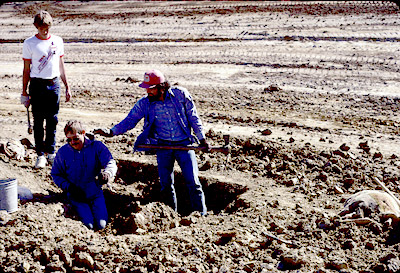
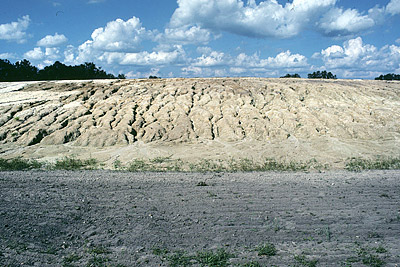
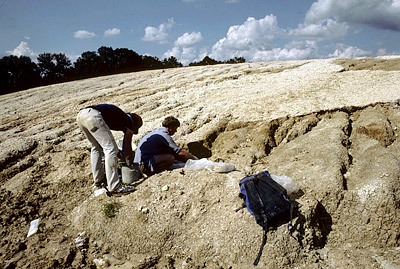
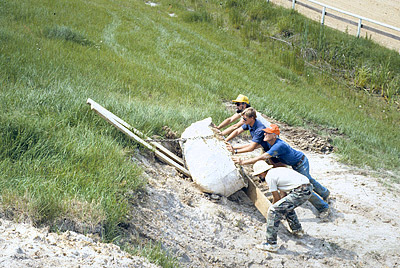
Discussion
The Moss Acres Racetrack Site is one the very few Florida fossil sites to produce large numbers of articulated vertebrate skeletons. Some of these are complete, or nearly so; in other cases only the bones from one or more limbs were found. Some isolated bones and teeth were also found here, but a remarkably high percentage of the fossils are parts of skeletons. The fauna is dominated by aquatic reptiles (turtles and alligator) and large mammals; other types of vertebrates are rare and not diverse (see list above). The two most common species are the rhino Aphelops mutilus and a small three-toed horse belonging to the genus Nannippus. The latter has sometimes been referred to the late Hemphillian species Nannippus aztecus (e.g., Hulbert, 1993), but it has some primitive features that indicate it could be considered a distinct species.
The most spectacular species found at the Moss Acres Racetrack Site was a new, very large species of shovel-tusk gomphothere, Amebelodon britti (Lambert, 1990). The size of its limb bones show that it rivals the largest Pleistocene mammoths for holding the record of largest proboscidean to have ever lived in Florida. Most gomphotheres, while still large mammals, are substantially smaller. The remains of at least two individuals of Amebelodon britti were found at the site.
Other impressive specimens found at the Moss Acres Racetrack Site were single skeletons of the extinct otter Enhydritherium terraenovae (Lambert, 1997), the three-horned artiodactyl Pediomeryx hemphillensis, and the megalonychid sloth Pliometanastes protistus (unfortunately lacking the skull). The otter skeleton is on permanent display at the Florida Museum of Natural History. Another important specimen on public display at the museum is a forelimb from the one-toed horse Dinohippus, the oldest direct evidence of one-toed horses in eastern North America. A skull of a juvenile Dinohippus and two adult molar teeth were also found and are most similar in size and morphology to the early Hemphillian species Dinohippus spectans which was first found in eastern Oregon. But three-toed horses remained numerically superior to one-toed horses at this time in Florida, with at least seven species of tridactyl equids present at Moss Acres (Hulbert 1987, 1988a, 1988b, 1993a). One of these, a skeleton of a female Cormohipparion plicatile was found intermingled with the bones of either a late-term fetus or a very recently born foal. Given that the site was discovered because of the construction of a horse racetrack, the large number of fossil horse skeletons and species may appear to be a remarkable coincidence, but high equid diversity is true for most North American fossil sites in the late Miocene (Hulbert, 1993b).
Most Florida late Miocene sites with large samples of rhinos typically have two species, one in the genus Teleoceras and one in the genus Aphelops, and generally Teleoceras is more common (Hulbert, 2000). This is true of the Love Site, McGehee Farm, and Mixson’s Bone Bed localities. But Moss Acres Racetrack Site has only Aphelops, represented by about eight skeletons and numerous isolated finds. This sample has not yet been studied in detail but appears to be a more progressive species of Aphelops than found at Hh1 sites like McGehee Farm and Mixson’s Bone Bed. It is referred to Aphelops mutilus, a species first found in Nebraska but subsequently found at sites in Texas, New Mexico, Kansas, and Alabama. The absence of Teleoceras at Moss Acres is puzzlingly, as the inferred depositional environment is one traditionally associated with that genus and not the genus Aphelops (MacFadden, 1998). The only other late Miocene Florida site which has both large numbers of rhino fossils and more Aphelops than Teleoceras is Tyner Farm.
Along with the well preserved vertebrate specimens is a just-as-extraordinary, but as yet unstudied palynoflora (fossil pollen) (Lambert, 1994).
Sources
- Original Author(s): Christina Holland and Richard C. Hulbert Jr.
- Original Completion Date: September 23, 2012
- Editor(s) Name(s): Richard C. Hulbert Jr., Natali Valdes
- Last Updated On: August 21, 2015
This material is based upon work supported by the National Science Foundation under Grant Number CSBR 1203222, Jonathan Bloch, Principal Investigator. Any opinions, findings, and conclusions or recommendations expressed in this material are those of the author(s) and do not necessarily reflect the views of the National Science Foundation.
Copyright © Florida Museum of Natural History, University of Florida